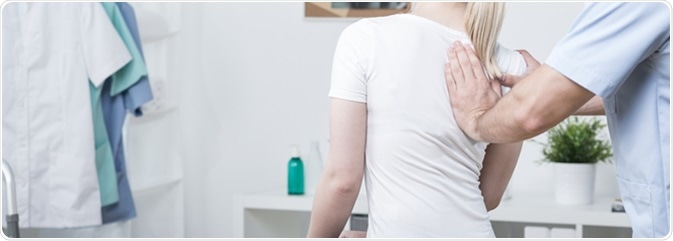Pediatric spinal deformities may be present at birth or may occur afterwards. Some of the most common deformities include pediatric scoliosis, kyphosis and spondylolysis.
Pediatric scoliosis is of many types: adolescent idiopathic scoliosis, neuromuscular scoliosis and congenital scoliosis.

Physiotherapist is rehabilitating patient with spine deformation. Image Credit: Photographee.eu / Shutterstock
During the history and physical examination many clues may help the clinician to diagnose the etiology, such as:
- Developmental delay
- Loose or hypermobile joints in Marfan syndrome or other collagen vascular disorders
- Axillary freckles, which are seen along with café au lait spots and skin nodules in neurofibromatosis
Clinical examination and radiology may offer further findings:
- Left-sided curve of the thoracic spine occurs in Charcot-Marie-Tooth disease, syringomyelia or cord tethering and requires further imaging and conduction tests of the whole spinal cord
- Facial or limb deformities may raise the suspicion of non-idiopathic etiology and should be followed up with renal ultrasound and echocardiography to rule out other congenital malformations
Adolescent Idiopathic Scoliosis
This type occurs in children who have no other obvious illness that could cause the spinal curvature. It occurs in girls more often than boys, especially as the magnitude of the curve increases above 30 degrees.
Idiopathic scoliosis is diagnosed in 65% of pediatric scoliosis cases. It has a strong familial basis. It was Harrington who first reported that women born to mothers who have more than 15 degrees of scoliotic curvature have a 27% higher chance of developing the condition themselves. It is also found in almost 75% of identical twins.
The genetic loci responsible are still to be identified. It is thought that multiple factors may be implicated. Some tests on the market take advantage of this finding, offering to test for several genetic markers in an effort to provide a prognosis for the curvature with relation to the test results, age and magnitude of the curve at the time of testing.
A novel test developed is the ScoliScore™, which compares these parameters to its standard curve to generate the patient risk for progression. It has been shown to have good positive and negative predictive values, but its clinical utility with respect to decision-making in the management of scoliosis is still under study.
Neuromuscular Scoliosis
Neuromuscular scoliosis results from nervous or muscular impairment which leads to lack of spinal support. It is associated with conditions such as muscular dystrophy, cerebral palsy, and neurofibromatosis. The result of such conditions is progressive and severe spinal curvature. It is usually of the long type and is C-shaped, often encompassing the whole of the spine.
As a result, the patient may have a permanently tilted spine with difficulty in sitting. Half of all patients with type 1 neurofibromatosis have scoliosis, which may be dystrophic or non-dystrophic, the latter being much more common. Pseudarthrosis is associated at a high frequency with the correction of this condition.
Congenital Scoliosis
Congenital scoliosis accounts for 15 of every 100 pediatric scoliosis cases. It is due to spinal structural abnormalities present at birth, which becomes more severe as the child grows producing progressive deformity. In contrast, the infantile form of idiopathic scoliosis has a normal spine structure.
Some of the underlying disorders in congenital scoliosis include defects of spinal segmentation, defects of spinal formation, and mixed defects. When they result in asymmetrical growth, they are more likely to cause scoliosis. Such high-risk conditions include unilateral bars, hemi-vertebrae and unsegmented bars with contralateral hemi-vertebra. Block vertebra are associated with the least risk of scoliosis progression.
The importance of diagnosing the basal defects lies in the need for early surgery to prevent intractable progression and severe deformity. The presence of such defects should prompt a whole body examination to rule out other defects, such as cardiac or genitourinary system malformations.
Other Spinal Deformities in Children
Spondylolysis is a common cause of back pain in teenagers who are athletically active. It is due to a stress fracture of one of the vertebrae, most commonly the fifth lumbar vertebra. When this starts to weaken the spinal column, the vertebral support is lost and one vertebra begins to slip over the lower one, impinging on the nerves and the spinal cord itself in severe cases. This condition is called spondylolisthesis and may require surgical correction.
Kyphosis is often caused by poor posture (postural kyphosis), or may be due to vertebral abnormality, and is then called Scheuermann’s kyphosis. The latter may be due to disturbances in vascular supply, but a genetic cause is also suspected. Congenital kyphosis is a third entity, which is present at birth. Other conditions that can lead to kyphosis include disorders, such as muscular dystrophy, spina bifida, neurofibromatosis, metabolic diseases, osteogenesis imperfecta, tuberculosis and tumors of the spine.
References
Further Reading
Last Updated: Dec 29, 2022